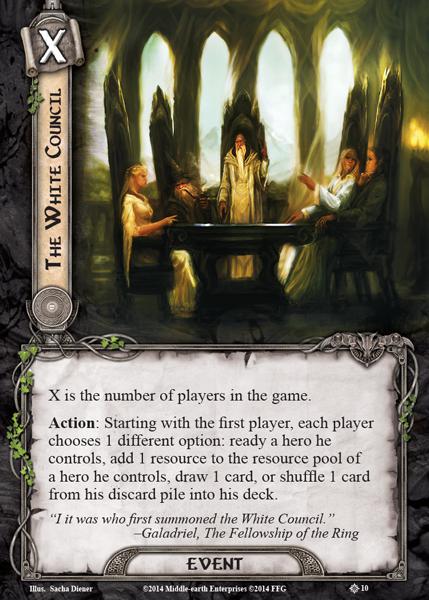I'll admit it: I love cards that can do more than one thing. Maybe it's because I was a utility player when I played baseball. Like Miruvor, the utility player of attachments, The White Council is the utility player of events and can do four different things. Unlike Miruvor, it can only do one of those things at a time, but has more flexibility as to who and what it can affect and where and when it can do so. It also has a different flavor depending on whether you're playing solo or multi-player. This review will only look at its application in one-handed solo play.
As a Neutral card costing 1 resource in one-handed solo play, it can fit into any deck and can have one of four different effects: 1.) ready a hero you control, 2.) add 1 resource to the resource pool of a hero you control, 3.) draw 1 card, or 4.) shuffle 1 card from your discard pile into your deck. While there are often better cards to provide each of these effects individually, it is the flexibility of The White Council that make it a solid card to consider. Let's look at each of its effects:
Since action advantage is almost always useful, paying 1 resource to ready 1 hero is a pretty good effect. It can't be played for 0-cost like Cram or give you an additional effect like Miruvor or Lembas, but unlike those attachments, which must be attached in the Planning Phase before they can be used and can only ready the attached hero, The White Council can be played from your hand in any phase to ready any hero you control. A Miruvor in your hand won't help you ready a hero in the Combat Phase to defend, but The White Council can. And unlike other events that can ready a hero--Behind Strong Walls, Hold Your Ground!, Tale of Tinúviel, or Flame of Anor, for example--The White Council requires no resource matching and has no restrictions or conditions, though it lacks those cards' additional effects. It is basically Swift and Silent played outside of Secrecy mode. But while I probably wouldn't include Swift and Silent in a non-Secrecy deck, I might include The White Council for its additional effects...
In solo play, paying 1 resource to gain 1 resource might, at first glance, seem to be pointless. However, if you look at the effect as resource smoothing rather than resource acceleration, it is similar to the effects of Bifur or Denethor, but with more flexibility since, as a Neutral card with no restrictions, any hero of any sphere can pay for it, while its effect can provide its resource to any hero of any sphere. And while Bifur & Denethor can only move one resource per round, you can play up to 3 copies of The White Council in the same round to move 3 resources between any heroes. Of course, Bifur and Denethor aren't taking up slots in your deck but, then, The White Council also offers other effects to choose from...
Paying 1 resource to draw 1 card certainly won't make The White Council your first choice for card drawing. In solo play, it is basically Campfire Tales without the sphere restriction. However, unlike other card drawing events of similar or lower cost--Mithrandir's Advice, Foe-hammer, Valiant Sacrifice, Deep Knowledge, or even Daeron's Runes--it has no restrictions, conditions, or additional costs, so can be played in any deck at any time for just 1 resource. While this doesn't make it a replacement for any of those cards, it can be useful as an additional method of card drawing, especially in the early game when other card drawing effects have yet to materialize. If this were The White Council's only effect, I would file it with Campfire Tales for solo play. Luckily, though, it offers other effects to choose from...
Last, but certainly not least, shuffling 1 card from your discard pile back into your deck is definitely an effect that makes The White Council worth considering. In fact, when I put it in a deck, it is usually for this purpose, with its readying and card drawing providing useful alternate effects, when needed. Unlike Dwarven Tomb, To me! O my kinsfolk!, Second Breakfast, or Tome/Scroll/Map/Book, it won't put that recycled card back into your hand or directly into play but, again, it has no restrictions. For 1 Neutral resource it can recycle any card, giving you up to 6 chances to play Tale of Tinúviel in a Dúnedain/Noldor deck or Lembas in a Treebeard deck or Gandalf in any deck. And, if your deck is built around a crucial card, you probably already have a way to fish it from your deck, like Galadhrim Minstrel, Master of the Forge, or Timely Aid.
In the end, The White Council's range of effects, as well as its flexibility regarding who and what it can target and where and when it can target them answers the question of why you may want to include it in your deck. All hail the Utility Player!
